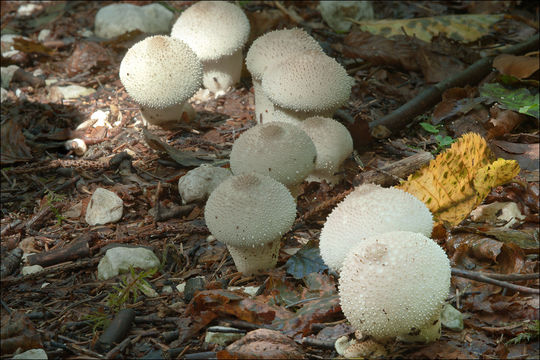Image of common puffball

Description:
Slo.: betiasta pranica - Habitat: Right on the path between two village houses; surrounded with abandoned pastures and mixed wood; almost flat, semiruderal, calcareous terrain; in shade, relatively moist place; exposed to direct rain; average precipitations ~ 3.000 mm/year, average temperature 7-9 deg C, elevation 595 m (1.950 feet), alpine phytogeographical region.Substratum: rather skeletal soil with raw humus (mostly rotten leaves of Fagus sylvatica)Comments: Lycoperdon perlatum is our most common puffball, growing in very wide range of habitats and on all kind of soils. Yet it is very beautiful (if not too mature). It is easy to recognize it by its interesting fruitbody surface, which is covered by 1 to 2 mm high, conical (or sometimes of quite funny shape) warts, which are surrounded by a ring of lower warts around them. With time the large warts fall off and the lower ones appear like a kind of delicate. regular 'net' on the surface of the fruit bodies, which is typical for the species. Photographed fungi were growing in a group of more than ten fruit bodies growing right in the middle of a mountain path.Spores warty. Dimensions: 3,5 [3,8 ; 3,9] 4,2 x 3,3 [3,6 ; 3,8] 4,1 microns; Q = 1 [1,0] 1,1; N = 40; C = 95%; Me = 3,8 x 3,7 microns; Qe = 1. Capillitium hyphae diameter about 4-5 microns; not septated, very sparsely branched. Olympus CH20, NEA 100x/1.25, magnification 1.000 x, oil, in water; in vivo. AmScope MA500 digital camera.Herbarium: Mycotheca and lichen herbarium (LJU-Li) of Slovenian Forestry Institute, Vena pot 2, Ljubljana, Index Herbariorum LJFPicture captions:Pic. 3M - Most of the spores observed were grouped in strange clumps. I do not know why and what this means.Pic. 4M - Capillitium hyphae not septated, very sparsely branched.Ref.:(1) S. Buczacki, Collins Fungi Guide, Collins (2012), p 432. (2) R.M. Daehncke, 1200 Pilze in Farbfotos, AT Verlag (2009), p 1089. (3) J. Breitenbach, F. Kraenzlin, Eds., Fungi of Switzerland, Vol.2., Verlag Mykologia (1986), p 399. (4) G.J. Krieglsteiner (Hrsg.), Die Grosspilze Baden-Wrttembergs, Band 2., Ulmer (2000), p 151. (5) R. Phillips, Mushrooms, Macmillan (2006), p 330. Nikon D700/Nikkor Micro 105mm/f2.8
Included On The Following Pages:
- Life (creatures)
- Cellular (cellular organisms)
- Eukaryota (eukaryotes)
- Opisthokonta (opisthokonts)
- Nucletmycea
- Fungi (mushrooms, lichens, molds, yeasts and relatives)
- Dikarya
- Basidiomycota (basidiomycete fungi)
- Agaricomycetes (Mushroom-Forming Fungi)
- Agaricales (Gilled Fungi)
- Agaricaceae
- Lycoperdon
- Lycoperdon perlatum (common puffball)
This image is not featured in any collections.
Source Information
- license
- cc-by-nc-sa-3.0
- copyright
- 2016 Dr. Amadej Trnkoczy
- photographer
- Dr. Amadej Trnkoczy
- original
- original media file
- visit source
- partner site
- CalPhotos
- ID


